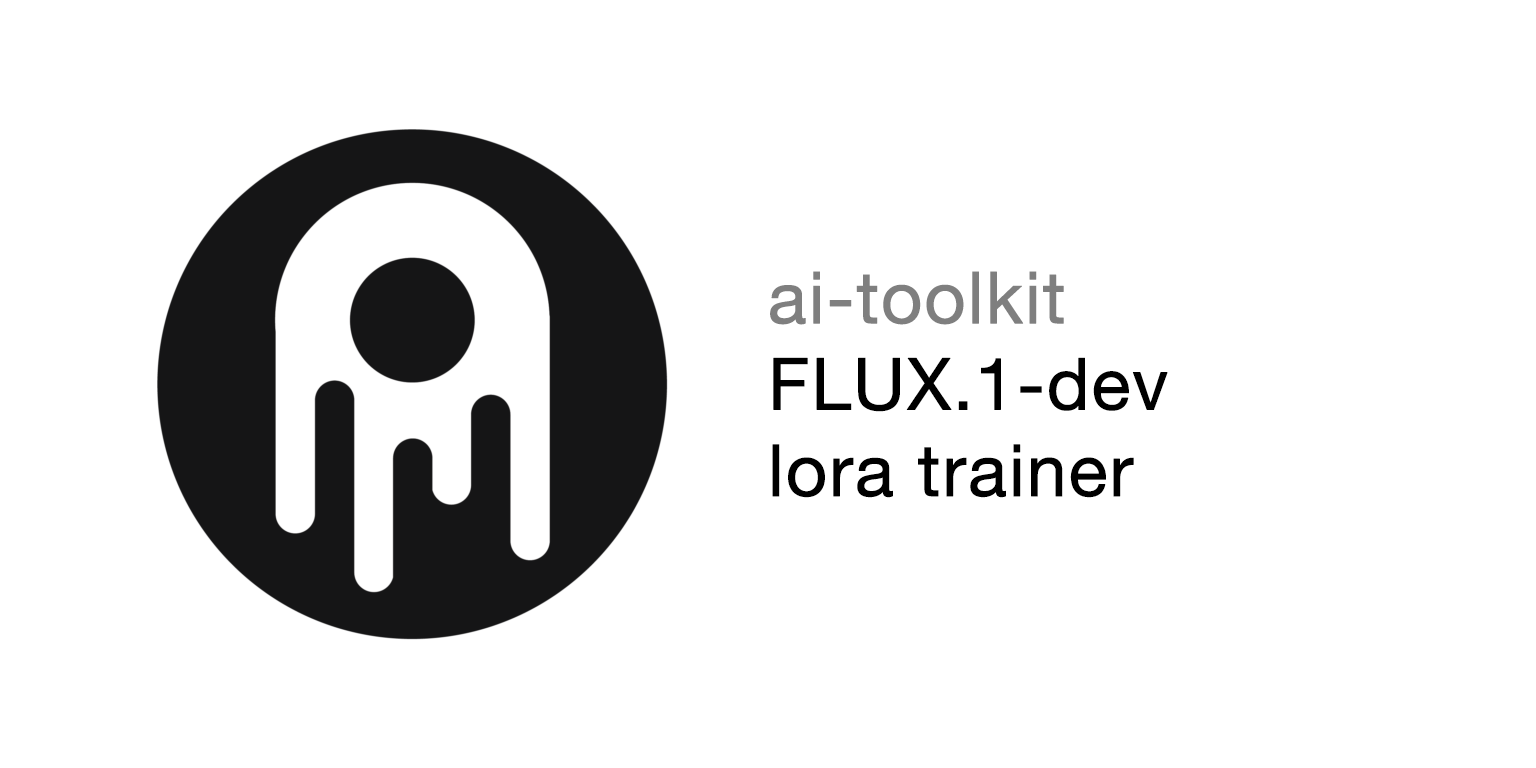flux-dev-lora-trainer
Maintainer: ostris

2.0K

| Property | Value |
|---|---|
| Run this model | Run on Replicate |
| API spec | View on Replicate |
| Github link | View on Github |
| Paper link | No paper link provided |
Create account to get full access
Model overview
The flux-dev-lora-trainer is an AI model developed by Ostris that allows users to fine-tune the FLUX.1-dev model using the AI-toolkit. This model is part of Ostris' research efforts and is designed to be a flexible and experimental platform for exploring different AI training techniques.
Similar models created by Ostris include the ai-toolkit, flux-dev-lora, flux-dev-multi-lora, flux-dev-realism, and flux-schnell-lora, all of which focus on different aspects of FLUX.1-dev and FLUX.1-schnell models.
Model inputs and outputs
The flux-dev-lora-trainer model is designed to fine-tune the FLUX.1-dev model using the AI-toolkit. The model accepts a variety of inputs, including the prompt, seed, aspect ratio, and other parameters that control the generation process.
Inputs
- Prompt: The text prompt that describes the desired image.
- Seed: The random seed used for generating the image.
- Model: The version of the FLUX.1 model to use, either the "dev" or "schnell" version.
- Width and Height: The desired width and height of the generated image.
- Aspect Ratio: The aspect ratio of the generated image, which can be set to a predefined value or "custom".
- Number of Outputs: The number of images to generate.
- Lora Scale: The strength of the LoRA (Low-Rank Adaptation) to be applied.
- Guidance Scale: The guidance scale for the diffusion process.
- Number of Inference Steps: The number of steps to take during the diffusion process.
Outputs
- Generated Images: The model outputs one or more images based on the provided inputs.
Capabilities
The flux-dev-lora-trainer model is designed to be a flexible and experimental platform for fine-tuning the FLUX.1-dev model. It allows users to experiment with different training techniques and settings, such as adjusting the LoRA scale, guidance scale, and number of inference steps. This can be useful for exploring how these parameters affect the quality and characteristics of the generated images.
What can I use it for?
The flux-dev-lora-trainer model can be used for a variety of research and development purposes, such as:
- Experimenting with different training techniques and settings for the FLUX.1-dev model
- Generating custom images based on specific prompts and requirements
- Exploring the capabilities and limitations of the FLUX.1-dev model
- Integrating the fine-tuned model into other applications or projects
Things to try
Some interesting things to try with the flux-dev-lora-trainer model include:
- Experimenting with different LoRA scales to see how they affect the generated images
- Adjusting the guidance scale to find the optimal balance between image quality and creativity
- Exploring the differences between the FLUX.1-dev and FLUX.1-schnell models and how they perform on various tasks
- Integrating the fine-tuned model into other applications or projects to see how it performs in real-world scenarios
This summary was produced with help from an AI and may contain inaccuracies - check out the links to read the original source documents!
Related Models

ai-toolkit

43
ai-toolkit is a collection of tools and utilities developed by Ostris for training and working with AI models, particularly related to the FLUX.1-dev model from Black Forest Labs. This toolkit includes features for batch image generation, LoRA and LoCON extraction, LoRA rescaling, and a LoRA slider trainer. The toolkit is designed to be modular, with the ability to create custom extensions that integrate with the framework. The ai-toolkit is similar to other LoRA training and management tools like the lora-training model from cloneofsimo, which provides presets for training LoRAs for faces, objects, and styles. It is also comparable to the flux-lora-collection from XLabs-AI, which provides a collection of trained LoRAs for the FLUX.1-dev model. Model inputs and outputs Inputs Prompt**: The text prompt used to generate images with the ai-toolkit. Outputs Image URI**: The generated image is returned as a URI, which can be used to retrieve the image. Capabilities The ai-toolkit provides a wide range of capabilities for working with AI models, including: Batch Image Generation**: The toolkit can generate batches of images based on prompts provided in a configuration file or text file. LoRA and LoCON Extraction**: The toolkit can extract LoRA and LoCON information from models, with support for various extraction methods like fixed, threshold, ratio, and quantile. LoRA Rescaling**: The toolkit can be used to rescale the weights of a LoRA, allowing you to adjust the effect of the LoRA on the base model. LoRA Slider Trainer**: The toolkit includes a slider training mechanism that allows you to train custom LoRAs that can be used as sliders in tools like Automatic1111. What can I use it for? The ai-toolkit is a valuable resource for researchers, developers, and artists working with AI models, particularly those focused on the FLUX.1-dev model. The batch image generation, LoRA and LoCON extraction, and LoRA rescaling features can be useful for tasks like model fine-tuning, dataset curation, and prompt engineering. The LoRA slider trainer is particularly useful for creating custom sliders that can be used to control specific aspects of generated images. Things to try Some interesting things to try with the ai-toolkit include: Experimenting with the various LoRA and LoCON extraction methods to see how they affect the resulting LoRA/LoCON. Using the LoRA rescaling tool to adjust the weight of existing LoRAs, allowing you to fine-tune their effect on the base model. Training custom LoRA sliders with the slider trainer, and incorporating them into your creative workflows. Developing custom extensions for the ai-toolkit to add new functionality, such as model merging or other specialized training tasks.
Updated Invalid Date

flux-dev-lora

1.2K
The flux-dev-lora model is a FLUX.1-Dev LoRA explorer created by replicate/lucataco. This model is an implementation of the black-forest-labs/FLUX.1-schnell model as a Cog model. The flux-dev-lora model shares similarities with other LoRA-based models like ssd-lora-inference, fad_v0_lora, open-dalle-1.1-lora, and lora, all of which focus on leveraging LoRA technology for improved inference performance. Model inputs and outputs The flux-dev-lora model takes in several inputs, including a prompt, seed, LoRA weights, LoRA scale, number of outputs, aspect ratio, output format, guidance scale, output quality, number of inference steps, and an option to disable the safety checker. These inputs allow for customized image generation based on the user's preferences. Inputs Prompt**: The text prompt that describes the desired image to be generated. Seed**: The random seed to use for reproducible generation. Hf Lora**: The Hugging Face path or URL to the LoRA weights. Lora Scale**: The scale to apply to the LoRA weights. Num Outputs**: The number of images to generate. Aspect Ratio**: The aspect ratio for the generated image. Output Format**: The format of the output images. Guidance Scale**: The guidance scale for the diffusion process. Output Quality**: The quality of the output images, from 0 to 100. Num Inference Steps**: The number of inference steps to perform. Disable Safety Checker**: An option to disable the safety checker for the generated images. Outputs A set of generated images in the specified format (e.g., WebP). Capabilities The flux-dev-lora model is capable of generating images from text prompts using a FLUX.1-based architecture and LoRA technology. This allows for efficient and customizable image generation, with the ability to control various parameters like the number of outputs, aspect ratio, and quality. What can I use it for? The flux-dev-lora model can be useful for a variety of applications, such as generating concept art, product visualizations, or even personalized content for marketing or social media. The ability to fine-tune the model with LoRA weights can also enable specialized use cases, like improving the model's performance on specific domains or styles. Things to try Some interesting things to try with the flux-dev-lora model include experimenting with different LoRA weights to see how they affect the generated images, testing the model's performance on a variety of prompts, and exploring the use of the safety checker toggle to generate potentially more creative or unusual content.
Updated Invalid Date

flux-dev-multi-lora

281
The flux-dev-multi-lora is an AI model developed by lucataco, who has created several similar models such as the flux-dev-lora, ssd-lora-inference, and ai-toolkit. This model is part of the FLUX.1-Dev series and allows for the exploration of multi-LoRA capabilities. Model inputs and outputs The flux-dev-multi-lora model takes in a variety of inputs to generate images, including a prompt, seed, aspect ratio, number of outputs, guidance scale, number of inference steps, and the ability to specify Hugging Face LoRA paths and scales. The outputs are an array of image URLs in the specified format, such as WEBP. Inputs Prompt**: Text prompt for the generated image Seed**: Random seed for reproducible generation Hf Loras**: Hugging Face paths or URLs to the LoRA weights Lora Scales**: Scales for the LoRA weights, default is 0.8 Num Outputs**: Number of images to generate, up to 4 Aspect Ratio**: Aspect ratio for the generated images, default is 1:1 Output Format**: Format of the output images, default is WEBP Guidance Scale**: Guidance scale for the diffusion process, default is 3.5 Output Quality**: Quality of the output images, from 0 to 100, default is 80 Num Inference Steps**: Number of inference steps, default is 28 Disable Safety Checker**: Option to disable the safety checker for generated images Outputs Array of image URLs**: The generated images in the specified format Capabilities The flux-dev-multi-lora model allows for the exploration of using multiple LoRA weights simultaneously during the image generation process. This can potentially lead to more nuanced and interesting image outputs by combining the effects of different LoRA models. What can I use it for? The flux-dev-multi-lora model can be used for a variety of creative and experimental image generation tasks. For example, you could try combining different LoRA weights to see how they interact and influence the final output. This model could be useful for artists, designers, or anyone interested in exploring the capabilities of AI-generated imagery. Things to try One interesting thing to try with the flux-dev-multi-lora model is to experiment with different combinations of LoRA weights and scales. By adjusting these parameters, you can potentially create unique and unexpected image outputs that blend the characteristics of multiple LoRA models. This can be a fun and rewarding way to discover new and surprising visual styles.
Updated Invalid Date

flux-schnell-lora

76
The flux-schnell-lora is an AI model developed by lucataco and is an implementation of the black-forest-labs/FLUX.1-schnell model as a Cog model. This model is an explorer for the FLUX.1-Schnell LoRA, allowing users to experiment with different LoRA weights. Model inputs and outputs The flux-schnell-lora model takes a variety of inputs, including a prompt, a random seed, the number of outputs, the aspect ratio, the output format and quality, the number of inference steps, and the option to disable the safety checker. The model outputs one or more generated images based on the provided inputs. Inputs Prompt**: The text prompt that describes the image you want to generate. Seed**: A random seed to ensure reproducible generation. Num Outputs**: The number of images to generate. Aspect Ratio**: The aspect ratio of the generated images. Output Format**: The file format of the output images (e.g. WEBP, PNG). Output Quality**: The quality of the output images, ranging from 0 to 100. Num Inference Steps**: The number of inference steps to use during image generation. Disable Safety Checker**: An option to disable the safety checker for the generated images. Outputs Generated Images**: The model outputs one or more generated images based on the provided inputs. Capabilities The flux-schnell-lora model is capable of generating images based on text prompts, with the ability to explore different LoRA weights to influence the generation process. This can be useful for creative projects or exploring the capabilities of the underlying FLUX.1-Schnell model. What can I use it for? You can use the flux-schnell-lora model to generate images for a variety of creative projects, such as illustrations, concept art, or product visualizations. The ability to explore different LoRA weights can be particularly useful for experimenting with different artistic styles or visual effects. Things to try Some ideas for things to try with the flux-schnell-lora model include: Experimenting with different prompts to see how the model responds. Trying different LoRA weights to see how they affect the generated images. Comparing the output of the flux-schnell-lora model to other similar models, such as flux-dev-multi-lora, flux-dev-lora, or open-dalle-1.1-lora. Exploring the use of the flux-schnell-lora model in various creative or commercial applications.
Updated Invalid Date